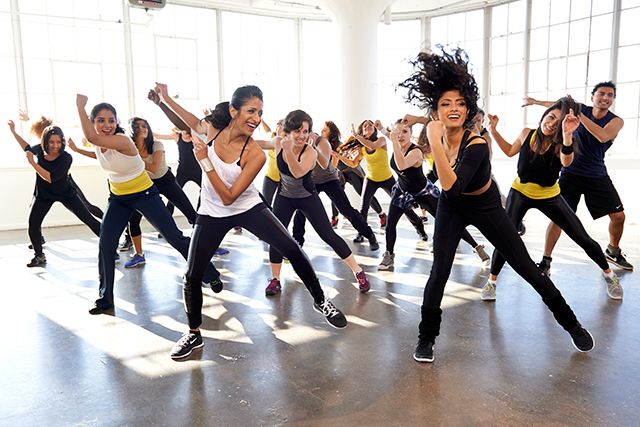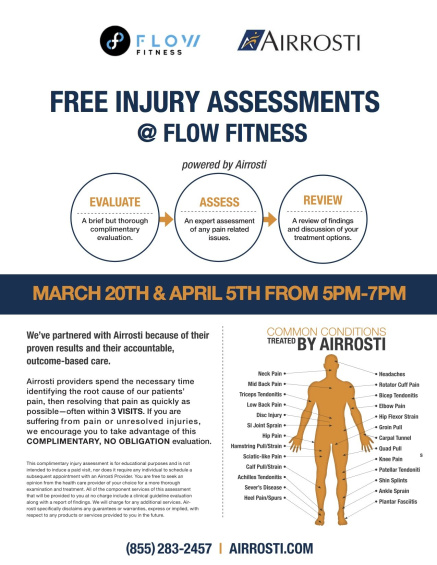BollyX ~ Friday, April 7th at 5:15pm
BollyX is a high intensity Bollywood cardio workout. Move to the heart pumping beats of Bollywood, get ready to feel that muscle burn and unleash your inner swagger.
Sometimes a workout can be just good ole fun!
 CategoriesEvent
CategoriesEventBollyX ~ Friday, April 7th at 5:15pm
BollyX is a high intensity Bollywood cardio workout. Move to the heart pumping beats of Bollywood, get ready to feel that muscle burn and unleash your inner swagger.
Sometimes a workout can be just good ole fun!
 CategoriesUncategorized
CategoriesUncategorizedStart your weekend off right with some dancing!
BollyX is a high intensity Bollywood cardio workout. Move to the heart pumping beats of Bollywood, get ready to feel that muscle burn and unleash your inner swagger.
You probably have a routine that you use for exercises. Maybe you work on your back, shoulders and arms one day and your legs, butt, and core the next. Maybe you alternate strength training with aerobic exercise. Whatever your typical workout regimen, there are probably important exercises that you aren’t performing.
Adding a few small exercises to appropriate points in your workout routine can improve the effectiveness of your regimen and reduce the likelihood of incurring a serious injury while you’re trying to improve your health and fitness.
Featured photo source: Pixabay.com
Professionals from many disciplines will attest to the fact that physical exercise has long been established as a key factor in reducing stress, anxiety, and battling depression. Stress affects not only the brain, but the rest of our bodies. When our bodies are physically challenged on a regular basis and in good health, our minds feel better as well. The endorphins produced from physical activity improves your sleep cycles which in turn, reduce stress.
The act of exercise itself produces important neurotransmitters such as serotonin, that are important for preventing depression and anxiety disorders. What forms of exercise are best for busting stress and keeping serotonin levels in balance? The answer to that is as varied as each person and their comfort levels.
Experts agree that regular exercise 3-5 times a week is as important as what types of workouts you choose. Hard bouts of cardio as well as weight training and deep stretching from yoga are all effective stress busters. Finding a form that works best for your personality and lifestyle is important so that you will stick with it.
If you are a social person, consider a group class to keep you in the game. If you are struggling with anger or over the top work stress, a kickboxing class may be just what the doctor ordered. The intensity inherently releases endorphins leaving you with a feeling of achievement.
If focusing at work is a struggle, perhaps a yoga class to help you center and learn mind-body control and controlled breathing. One session will leave you with a sense of calm and positive outlook. Regular yoga proponents have significantly higher levels of the amino acid GABA, which is associated with depression and anxiety for people with lower levels.
Running has been shown to promote healthier moods because of the repetitive and rhythmic effects on the brain. The same is said of hiking to lower stress hormones. There is something about getting off the pavement, and smelling the outdoors with a break from urban surroundings that calms the mind. If you live too far from hiking trails, you will be surprised to find many “urban hikes” in the middle of Seattle.
Intense cardo 3-5 times a week for 30 minutes a session is recommended for optimal health. However, if it has been a while for you, don’t let that hold you back. Just get out there and do an interval approach that challenges you for a minute at a time, with rest intervals of 30-60 seconds. Continue this cycle for a total of 15 minutes, working up to 30 minutes and you will see improvement in your moods, as well as your fitness level improve within 2-3 weeks.
Remember, it is less important what form of exercise that you choose than it is to just get out there and DO IT!
Featured photo source: Pixabay.com
 CategoriesEvent
CategoriesEventYou’re dedicated to your health and well-being. You make a point of visiting the gym several times a week to ensure you engage in enough strength-training exercise, as well as aerobic exercise to promote your overall health. Did you know there are some simple tricks and tips that can help you make the most of your time at the gym?
Getting in better shape is a common goal among Americans, and one we are typically not very good at reaching. Every year, millions of Americans attempt diets and exercise regimens, only to fail within days of starting. Working with a personal trainer is one of the best options for individuals who are serious about enhancing their fitness and improving their overall health.
At Flow Fitness, we have an amazing team of personal trainers who can help you achieve the body and degree of fitness you’ve always wanted. Here are some reasons to consider a personal trainer through Flow Fitness.
 CategoriesEvent
CategoriesEvent$49 per test of $89 for both.
For more information and to see how it works visit here.
…plane of motion that is. Have no idea what I’m talking about?
There are three planes of motion: sagittal, frontal, and transverse.
At it’s most basic:
Sagittal = forward or backward (think lunges, running or cycling)
Frontal = side to side (side lunges or jumping jacks)
Transverse = rotational (twists of any sort, swinging a bat)
To picture the three planes, imagine slicing through the body, (like in the picture):
First through the center, dividing the body from the left to the right for the Sagittal plane.
Next through the body from the left side to the right, separating the front and back halves to create the frontal plane (front side and back side).
Finally cutting straight through the hips to divide the top of the body from the bottom, the transverse plane.
The body moves in three dimensions and an ideal training program would reflect that. However, most of us hang out in the sagittal plane all the time, moving forward or back doing pushups, crunches, squats, lunges or simply hanging out on the elliptical, treadmill or stationary bike.
People that are in excellent shape as runners or cyclists are often shocked upon changing up their programs and learning how weak they are in the frontal and transverse planes. Building in exercises in other planes helps your body naturally prevent injury, increase your range of motion, and ensure good balance.
Plus, activities in sports and daily life require movement in all three planes simultaneously. A forehand in tennis, , squatting to lift and carry a toddler, a spike in volleyball, grocery shopping, and a golf swing are all multi-plane movements.
When you come to the gym or workout in any way, aim to involve all three planes of motion. Work in some side lunges, or a twist. Do some jumping jacks or oblique crunches. Develop a yoga practice or go to training camp. This will ensure that your exercise routine has a better carry-over to sport and to life.
We are now six weeks into 2017. Most consistent gym enthusiasts have noticed a major influx of new faces running on treadmills, attending classes or lifting weights. The consistent gym enthusiasts have seen this play out before: crowded gym for the first 6-8 weeks of the new year, then a drop off as March approaches. Sadly, a stunning 80% of individuals embarking on their health and wellness resolutions are not seen after six weeks into the new year. Here are three simple solutions to ensure you won’t be on the wrong side of statistics:
1. SCHEDULE YOUR GYM TIME AS IF IT WERE A WORK MEETING:
Imagine this scenario: It’s been a busy day at the office and time is flying by. You planned a Noon workout, yet all of a sudden you get a notification that your 1 pm meeting is about to begin. You realized you were so focused on work that you completely missed your “designated” workout time. This is an all-to-common scenario. When many people do not put their workouts into their schedule, it becomes very easy to let time slip away and another workout is lost. A workout lost=lost momentum. Lost momentum= lost consistency. And thus the vicious cycle begins. Put it in your calendar at the beginning of the week and as soon that notification alerts you, GET UP AND GO!
2. PRINT OUT A CALENDAR AND CROSS OFF EVERY DAY YOU SUCCESSFULLY MAKE IT TO THE GYM:
There is something truly powerful about visually writing goals down and “checking the boxes”. Simply setting a goal of “X” amount of days a week to get to the gym and crossing those days off on a physical calendar helps to reinforce the habit of making it to the gym, while giving you the visual perspective of how much momentum you have truly built.
3. SWITCHING UP YOUR WORKOUT TO KEEP SEEING RESULTS:
The reality is most people embarking on New Year’s health and wellness goals gravitate to simply running on the treadmill. The first couple weeks these individuals see weight coming off, yet as each week goes on, results drop off more and more. Reason being, the body adapts to consistent stimulus. Try this: Warm up with a five minute run, then perform 10 Rounds of a :30 Sprint followed by a one minute walk. Not only is this type of intensity going to yield much better results, this should also take you much less time. Who doesn’t want to spend less time in the gym and see better results?
post written by Flow Fitness Personal Trainer, Drew Ridge